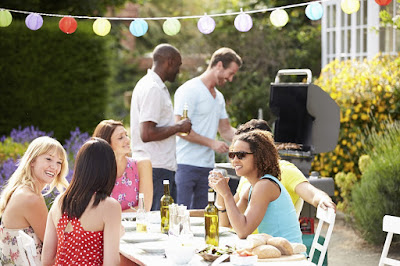With warmer weather comes the outdoors. Bears aren’t hibernating, snow isn’t falling, and we’re spending more time lounging by the pool. What’s missing? MUSIC! No worries, here’s your complete buying guide for an outdoor speaker system.
 |
| Image Source: http://stlmosquitocontrol.com/uncategorized/keep-mosquitoes-from-ruining-your-outdoor-party/ |
Ahhh, do you feel that? Do you feel the heat slowly creeping back into your bones? Well, fire up the grill, take a dip in the pool, and get ready because it’s been a long winter, a brief spring, and summer is finally here!
As we transition from indoors to outdoors and from pasty to tan, you find yourself spending more and more time scratching your head because our cool and awesome smartphones just can’t produce the same sound we know and love from indoor speakers. You need volume, you need power, but most of all, you need an outdoor speaker system!
Outdoor Speaker System: Why You Need It
Picture it: it’s a hot summer day, you’re grilling some burgers, and you get a hankering for some tunes. The problem? You’re in the great outdoors and your indoor system is that, an indoor system. Wait a second, you say, that’s no problem. I have a nice set of outdoor speakers!
With one you’ll be the talk of the block and the envy of the neighborhood as you blast music and jam to your favorite songs…all day long. Sound good? Well, sit tight, because here’s what you need to know before buying an outdoor speaker system.
Location, Location, Location
Outdoor speakers, like their indoor counterparts, require a couple of considerations for optimal sound (and a few more because of the outdoor factor).
First and foremost, where will they be placed? Before you answer that, keep in mind where the listeners will be and the area you want to bless with sound. When setting up indoor speakers, you have to think about furniture placement and its material, as furniture blocks sound and certain materials absorb, amplify and distort it. When setting up outdoor speakers, you’ll most likely have to do the opposite and consider the absence of furniture.
The thing about sound outside is that you have to account for the inverse square law, or that “each doubling of distance drops the output by 6dB.” In case you’re not familiar with decibels, that’s a lot, especially when you factor background noises into the equation. Therefore, depending on the area you want to cover, you might want to spring for multiple speakers or more powerful ones.
 |
| Image Source: http://www.cepro.com/article/best_speaker_outdoor_acoustics |
After Location Comes Placement
We mentioned placement before, but here’s where it actually comes into play. To begin with, are you sure that your speakers are made for the outdoors? This whole thing is about outdoor speaker systems, so it’s important that they are, otherwise they’ll fry up the second it starts raining.
Once assured that they are indeed outdoor speakers, try to minimize their exposure by placing them under an awning, a canopy, or some other sort of shelter. While it’s true that they’re meant to withstand the elements, it’s not a good idea to test the limits.
You also have options for the physical placement. Namely, are you going to place or mount? Mounting has the advantage of better sound distribution, just don’t go above 10ft — doing so tends to dissipate sound. If you are mounting, make sure to find a sturdy location and face them downward for better sound directionality and water drainage.
One more thing in case you decide to use multiple speakers; go for stereo sound by pairing them and keeping them about 10ft apart.
Wired vs. Wireless: the Great Battle
 |
| Image Source: http://mcl.usc.edu/news/2015/04/12/mcl-research-on-coexistence-wi-fi-and-bluetooth-mac-design-published/ |
This section applies to two different types of wires — those that give your speakers power and those that you use to connect your devices. Focusing on the former first, some speakers are portable are can be used with batteries or rechargeable battery packs. These are excellent if you want the freedom to place them wherever you want without worrying about extension cords are outlets.
Moving to the other type of wire, your best bet is to use wireless speakers if you don’t want to be bogged down near the speaker. In other words, there’s no need to worry about distance from the music source because there are no wires, it’s all wireless! For this, you’ll encounter two types of wireless options: Bluetooth and WiFi. WiFi speakers have longer range and can be synced up with each other, so pick these if you’re going for multiple speakers.
Final Thoughts
Look for speakers that check as many boxes in your outdoor speaker system checklist. Some like the HEOS 1 speakers have a sealed enclosure for humidity protection, an optional rechargeable battery pack for when you don’t want the music to stop, Bluetooth integration, and WiFi connectivity to sync multiple speakers and stream from your favorite music service like Spotify, Pandora, iHeartRadio, SiriusXM, SoundCloud, TIDAL and more.
Whatever direction you take, best of luck choosing!
